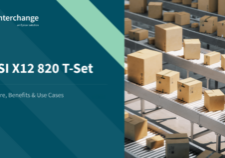Solving Supply Chain Problems in the Logistics Industry
Supply chains across the world have been impacted by the challenges posed by the COVID-19 pandemic. In 2020 alone, up to 35% of companies experienced delays in cross-border transportation, along with a host of other issues.1
This disruption magnified both old and modern supply chain challenges. As a result, the identification of effective solutions has gone from a back-of-house consideration to a priority for businesses across industries, logistics included.
At Data Interchange, we’ve spent decades helping businesses overcome supply chain and supplier management challenges with Electronic Data Interchange (EDI). In this article, we will look at some common supply chain issues in the logistics industry and the solutions available to businesses.
Let’s get started.
Suggested reading: Find out how you can gain a competitive advantage with EDI with our free eBook — The Supply Chain Centred Business


A lack of accuracy
Regardless of how smoothly a supply chain runs in theory, a lack of transparency can prevent the efficiency and performance levels necessary for prolonged success. This can arise from inaccurate or incomplete data across global supply chains, many of which were operating under challenging circumstances even before the pandemic.
Put simply, supply chain management processes will struggle to ensure high-quality products or efficient lead times if there are consistent inaccuracies reported in crucial processing data. These inaccuracies can emerge from:
- Product descriptions
- Product imagery
- Part lists
- Product specifications
For the logistics industry specifically, this is an issue that needs to be overcome to ensure accurate and on-time deliveries, particularly with customers that increasingly want to track shipments and get updates in real-time.
How EDI can help
By deploying an effective EDI solution, human errors that result in inaccurate data, like illegible handwriting, repeated manual errors and the loss of documents, can be permanently eliminated. As a result, the digitised sharing of supply chain documents that EDI facilitates is a cost-effective solution for increasing reporting accuracy and transparency across supply chains.
Moreover, EDI’s ability to improve real-time communications is becoming imperative, ensuring that documents don’t quickly become outdated or irrelevant. Instead, accurate and up-to-date information is easier to access and maintain than ever before.
Trading partner relationships
In recent times, global supply chains have drastically enhanced the reach and profitability of trading partnerships. However, growing distances can also pose problems within these relationships.
Issues such as logistical communication barriers, incompatible technology, and high levels of pressure in modern supply chains all have the potential to prevent the trust and efficiencies on which effective trading relationships ideally rest.
This is a significant problem within the logistics industry, hindering the benefits of effective supply chain management, which include:
- Reducing costs
- Aligning technologies
- Open and honest communication
In extreme cases, an inability to foster positive partner relationships can result in unfulfilled agreements, meaning that new suppliers have to be onboarded at higher than usual operational and monetary costs.
How EDI can help
Effective communication that enables increased operational ease and transparency to all partners across the supply chain is fast becoming a supplier relationship management touchstone. EDI solutions are making this possible by streamlining transactions and communication through the seamless exchange of relevant business documents.
Modern EDI solutions are proving crucial in creating positive relationships across even the most complex logistics supply chains. As a result, deficiencies within legacy EDI systems, such as incompatible standards and complex onboarding processes, can finally become a thing of the past. These new, modern solutions offer smooth integrations with partners who have little or no EDI experience, thereby accelerating the seamless sharing of files across supply chains.
Limited supply chain visibility
Limited visibility can lead to a range of issues within logistics supply chains, including a lack of accuracy and difficult supplier relationships. This is an issue impacting businesses across industries, with one survey suggesting that 57% of companies have poor visibility across their supply chains.2
Reduced visibility can be a particularly pressing issue when operations already have to contend with a range of other challenges. The result leaves a number of desirable supply chain outcomes out of reach, including:
- Risk foresight
- Positive partnerships
- Optimised inventory management
- Planned supply chain activities
- Resilient supplier management
How EDI can help
At the most basic level, EDI is designed to deliver the smooth transfer of digital files throughout supply chains. The result is increased levels of visibility facilitated by enhanced communication, thereby driving continual improvement and long-term efficiency.
Whilst undoubtedly improving visibility, legacy EDI has its limitations. By comparison, modern EDI solutions make it easier for all partners to operate across global supply chains. These new solutions can provide real-time file transfers that offer a previously unattainable level of visibility, allowing supply chain managers to better understand how the supply chain operates, where improvements can be made to optimise outcomes and how to build resilience.
The struggle for efficiency
As businesses around the world learnt the hard way after the onset of the COVID-19 pandemic, efficiency across supply chains is fundamental to gaining a competitive advantage and, in some instances, just for survival.
This was particularly true for the logistics industry, with one survey suggesting that 86% of respondents experienced a general downturn in business due to work or orders being cancelled in the early days of the pandemic.3
From visibility to relationships and beyond, everything that you do within a supply chain is leading towards the ultimate goal of efficiency, the achievement of which can open the doors for not just exceptional functioning, but also the optimisation of everyday processes, such as:
- Request fulfilment
- Timely delivery
- Budget management
In light of the increasing focus on business continuity and flexibility, efficient processes that make it easier to forecast and react to real-time changes in demand and operation are imperative for success.
How EDI can help
EDI has already proved pivotal in helping the logistics industry minimise the risks posed by inefficiency. This is primarily due to EDI’s ability to facilitate the seamless, real-time sharing of critical business documentation in real-time, regardless of the distance between suppliers and customers.
However, continually evolving customer expectations in logistics mean that EDI solutions themselves need to continue to develop. Customers are now increasingly expecting logistics partners to solve problems and help them drive growth, while delivery speeds are becoming more and more important to customers.
That’s why modern EDI solutions are looking to help improve efficiency further within global supply chains with the help of:
- Access to data that helps facilitate improvements in forecasting, risk assessment and decision-making processes
- Smooth onboarding processes
- Holistic supply chain oversight


Modern solutions are available
Strict supplier deadlines and trading requirements across territories mean that the supply chain issues detailed above can cause significant disruption in the logistics industry. Legacy EDI solutions and in-house expertise have previously helped to mitigate these issues. However, legacy solutions are struggling to meet the demands of modern supply chains, and in-house experts aren’t equipped with the tools to meet strict SLA timelines.
In-house expertise is practically necessary to meet strict supplier demands but EDI teams aren’t always equipped with the tools necessary to meet them. In order to be able to fulfill supplier requirements from the moment of agreement, in-house EDI teams require the tools to fulfill requests in sharply reduced timelines.
At Data Interchange, we call this DiNet. Used by our own teams, our Value Added Network grants access to a library of mapping templates that can be utilised by in-house EDI teams. By accommodating a range of standards and protocols, this approach removes barriers to EDI adoption across supply chains, ensuring agile and productive relationships even when partners have specific requirements around EDI. With DiNet, businesses also benefit from cutting-edge EDI tools that go beyond traditional solutions and can obtain additional support from experts who act as an extension of their in house teams, enabling smooth integrations and enhanced visibility.
Learn more about how your organisation can overcome complex issues within the supply chain and gain an edge over the competition by talking to an expert today.
1 Impact of the coronavirus pandemic on supply chains across industries 2020
2 2019 Supply Chain Statistics | 10 More Shocking Figures
3 Logistics UK’s Coronavirus Logistics Impact Surveys



























































































































